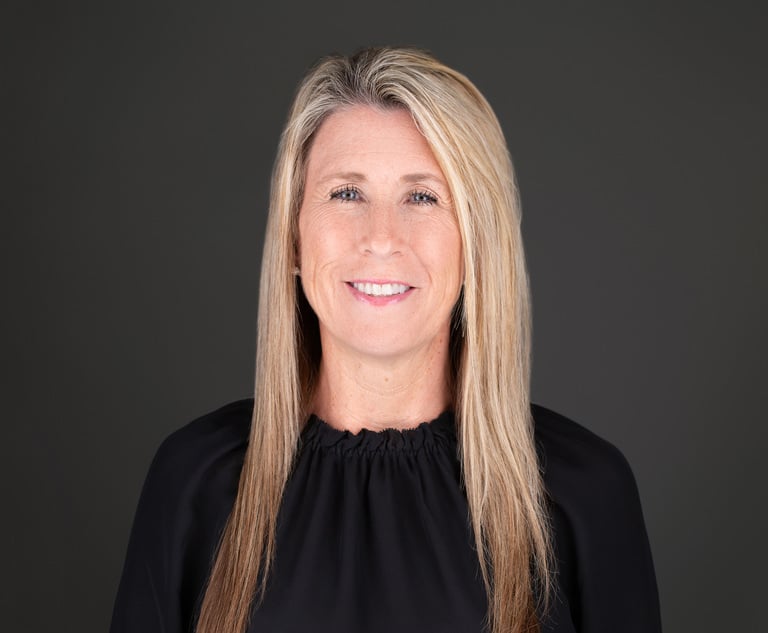Solo Cup Decision Makes It Easier to Defend False Patent Marking Cases
The Federal Circuit court rules that, to be liable under the false patent marketing statute, a company must consciously intend to decieve.
August 19, 2010 at 08:00 PM
6 minute read
The first half of 2010 was rough on businesses that own patents. Many such firms were swept up in a flood of new lawsuits, thanks to a Federal Circuit ruling in late 2009 that revitalized a previously obscure provision of patent law punishing those who incorrectly mark their products as patented. People seeking to make a quick buck went to court, alleging that businesses had marked their products with incorrect patent numbers and demanding damages of $500 for each wrongly marked item.
A defendant's potential liability was staggering. Solo Cup Co., for instance, was sued for $10.9 trillion dollars–an amount equal to more than 80 percent of the U.S. national debt.
But what the Federal Circuit gives, the Federal Circuit can take away. And in June, the court gave patent owners a major victory–though not everything they wanted–in Pequignot v. Solo Cup Co. The ruling clarifies when a patentee can be liable for false patent marking, requiring a standard of culpability that is tough for plaintiffs to prove.
“The opinion made it very clear that mere negligence or even recklessness will not suffice to make a company liable under the false patent marking statute. The company has to consciously desire for the public to be deceived [by the false markings],” says Frank DiGiovanni, a partner at Connolly Bove Lodge & Hutz.
Relators Gold Rush
The false patent marking statute seems fairly straightforward. It states that anyone who, “for the purpose of deceiving the public,” marks an “unpatented article” as patented will be “fined not more than $500 for every such offense.” Enforcement is by qui tam suits; anyone can become a “relator,” filing a lawsuit and, if the suit is successful, receiving half of the defendant's fines, while the other half goes to the federal government.
For 100 years, the courts minimized the effect of the statute by ruling that a continuous false marking–such as the entire production run of a product–is a “single offense.” The fines were so small it was rarely worthwhile to file suit.
That all changed in December 2009, when the Federal Circuit issued its ruling in Forest Group Inc. v. Bon Tool Co. The court held that each wrongly marked item is a separate offense under the statute.
Some people saw a golden opportunity. They could rake in millions by suing businesses whose mass-produced items were incorrectly marked. In the six months following the Bon Tool ruling, relators filed approximately 250 false patent marking suits.
Matthew Pequignot beat the rush. A licensed patent attorney who has brought false marking suits against a number of companies, he sued Solo Cup Co. in 2007. The company had two patents on its cup lids, but continued to mark its lids with those patent numbers for years after the patents expired. Pequignot alleged that more than 21.7 billion lids were wrongly marked, and he sought $500 in damages for each lid.
A federal district court in Virginia threw out Pequignot's suit on a number of grounds. He appealed to the Federal Circuit.
Solo Cup argued that it could not have violated the false marking statute because its lids were not covered by the statute. The statute applies only to “unpatented articles,” while its lids had once been patented.
The Federal Circuit didn't buy that argument. The three judge panel unanimously held that “an article covered by a now-expired patent is 'unpatented.'”
Businesses were disappointed by that part of the ruling. If it had gone the other way, companies would have faced no liability for continuing to mark articles with patent numbers, even after those patents expired. That standard would have enabled defendants to easily rid themselves of the majority of false marking suits filed in 2010, according to Jordan Sigale, a partner at Loeb & Loeb. “It would have given a bright-line test allowing many cases to be dismissed on summary judgment,” he says.
Corporate Road Map
However, businesses cheered another part of the Federal Circuit's opinion. The court held that in order to violate the false marking statute, a defendant must specifically intend to deceive the public by falsely marking its products as patented.
If a defendant knows its products are falsely marked, that creates a presumption the company intended to deceive, according to the Federal Circuit's 2005 ruling in Clontech Labs., Inc. v. Invitrogen Corp. But this presumption can be overcome, the court held in Solo Cup, if a defendant shows by a preponderance of the evidence that it had good faith reasons for mismarking its products. Solo Cup Co. met this standard, the court ruled in upholding summary judgment for the company, because it adopted a commercially reasonable business practice based on advice from outside counsel.
The molds used to manufacture Solo's cup lids often last 15 to 20 years, and the company would have faced significant costs and business disruption if it attempted to replace these molds immediately upon the expiration of the relevant patents. Acting in consultation with its outside intellectual property counsel, Solo decided that whenever its molds needed to be replaced due to wear or damage, the new molds would not include expired patent marks.
“The ruling gives companies a road map for getting out of harm's way in the future. Talk to an attorney, develop a plan to remove false patent markings over a few years, then you'll probably be okay,” says Thad Kodish, a principal at Fish & Richardson.
But even if a company follows this road map, resolving a false marking suit may not be easy. Says Sigale, “Intent [to deceive] is a question of fact that often can't be resolved easily on summary judgment, so defendants will be left with expensive litigation under the false marking statute. And companies will continue to think about whether they should settle these suits.”
This content has been archived. It is available through our partners, LexisNexis® and Bloomberg Law.
To view this content, please continue to their sites.
Not a Lexis Subscriber?
Subscribe Now
Not a Bloomberg Law Subscriber?
Subscribe Now
NOT FOR REPRINT
© 2025 ALM Global, LLC, All Rights Reserved. Request academic re-use from www.copyright.com. All other uses, submit a request to [email protected]. For more information visit Asset & Logo Licensing.
You Might Like
View All
Amex Latest Target as Regulators Scrutinize Whether Credit Card Issuers Deliver on Rewards Promises

Wells Fargo and Bank of America Agree to Pay Combined $60 Million to Settle SEC Probe

‘Extremely Disturbing’: AI Firms Face Class Action by ‘Taskers’ Exposed to Traumatic Content
5 minute readTrending Stories
- 1Newsmakers: Former Pioneer Natural Resources Counsel Joins Bracewell’s Dallas Office
- 2Quiet Retirement Meets Resounding Win: Quinn Emanuel Name Partner Kathleen Sullivan's Vimeo Victory
- 3Avoiding the Great Gen AI Wrecking Ball: Ignore AI’s Transformative Power at Your Own Risk
- 4A Lesson on the Value of Good Neighbors Amid the Tragedy of the LA Fires
- 5Change Is Coming in the Trump Era. For Big Law, Change Is Already Here
Who Got The Work
J. Brugh Lower of Gibbons has entered an appearance for industrial equipment supplier Devco Corporation in a pending trademark infringement lawsuit. The suit, accusing the defendant of selling knock-off Graco products, was filed Dec. 18 in New Jersey District Court by Rivkin Radler on behalf of Graco Inc. and Graco Minnesota. The case, assigned to U.S. District Judge Zahid N. Quraishi, is 3:24-cv-11294, Graco Inc. et al v. Devco Corporation.
Who Got The Work
Rebecca Maller-Stein and Kent A. Yalowitz of Arnold & Porter Kaye Scholer have entered their appearances for Hanaco Venture Capital and its executives, Lior Prosor and David Frankel, in a pending securities lawsuit. The action, filed on Dec. 24 in New York Southern District Court by Zell, Aron & Co. on behalf of Goldeneye Advisors, accuses the defendants of negligently and fraudulently managing the plaintiff's $1 million investment. The case, assigned to U.S. District Judge Vernon S. Broderick, is 1:24-cv-09918, Goldeneye Advisors, LLC v. Hanaco Venture Capital, Ltd. et al.
Who Got The Work
Attorneys from A&O Shearman has stepped in as defense counsel for Toronto-Dominion Bank and other defendants in a pending securities class action. The suit, filed Dec. 11 in New York Southern District Court by Bleichmar Fonti & Auld, accuses the defendants of concealing the bank's 'pervasive' deficiencies in regards to its compliance with the Bank Secrecy Act and the quality of its anti-money laundering controls. The case, assigned to U.S. District Judge Arun Subramanian, is 1:24-cv-09445, Gonzalez v. The Toronto-Dominion Bank et al.
Who Got The Work
Crown Castle International, a Pennsylvania company providing shared communications infrastructure, has turned to Luke D. Wolf of Gordon Rees Scully Mansukhani to fend off a pending breach-of-contract lawsuit. The court action, filed Nov. 25 in Michigan Eastern District Court by Hooper Hathaway PC on behalf of The Town Residences LLC, accuses Crown Castle of failing to transfer approximately $30,000 in utility payments from T-Mobile in breach of a roof-top lease and assignment agreement. The case, assigned to U.S. District Judge Susan K. Declercq, is 2:24-cv-13131, The Town Residences LLC v. T-Mobile US, Inc. et al.
Who Got The Work
Wilfred P. Coronato and Daniel M. Schwartz of McCarter & English have stepped in as defense counsel to Electrolux Home Products Inc. in a pending product liability lawsuit. The court action, filed Nov. 26 in New York Eastern District Court by Poulos Lopiccolo PC and Nagel Rice LLP on behalf of David Stern, alleges that the defendant's refrigerators’ drawers and shelving repeatedly break and fall apart within months after purchase. The case, assigned to U.S. District Judge Joan M. Azrack, is 2:24-cv-08204, Stern v. Electrolux Home Products, Inc.
Featured Firms
Law Offices of Gary Martin Hays & Associates, P.C.
(470) 294-1674
Law Offices of Mark E. Salomone
(857) 444-6468
Smith & Hassler
(713) 739-1250







